Ladies' Dresses 1880s-1930s
In Victorian and early 20th-century fashion, the dress was constructed in two parts. The bodice was the upper part along with a skirt. This pairing had the advantage of allowing a voluminous skirt to be paired with a close-fitting bodice, and of allowing two or more bodices to be worn with the same skirt (e.g., a high-necked bodice and a low-necked bodice allowed the same skirt to serve for both daywear and evening wear).
One-piece construction became more common after 1900 due to the trend for looser, more simply-constructed clothing with narrower skirts.
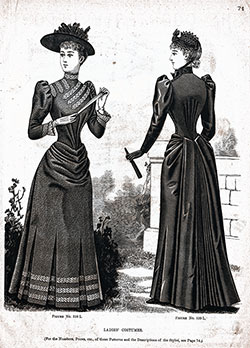
Ladies Stylish Costumes 338L and 339L - 1890
Figure No. 338 L represents a front view of the costume, showing it developed in dark cheviot, with ruffles of white lace and an effective arrangement of white basket braid for garniture. The skirt is in the received four-gored style and is only slightly revealed by the over-dress.
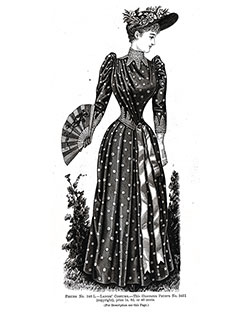
The costume represented here is developed in spotted India silk, with Vandyke lace and ribbon for decoration. The skirt is in the popular four-gored style, and a small bustle may be worn if desired.
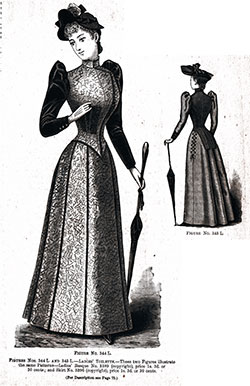
Ladies Ensemble Dress 344 L and 345 L - 1890
Figure No. 344 L shows the ensemble dress developed in fancy suiting and black velvet, with black velvet cordings, small bone buttons and simulated button-holes of cord for decoration.
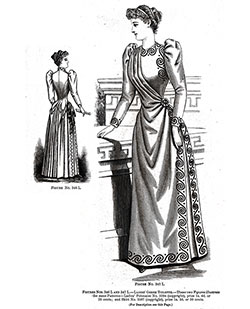
Ladies Greek Costume 346 L and 347 L - 1890
The costume will develop attractively in Henrietta cloth, serge, camel-hair, and all fabrics of a soft, clinging nature. One material may be used throughout, or velvet may be employed for the sleeves, its richness of texture serving to emphasize the classic folds that are shown to best advantage in woolens.
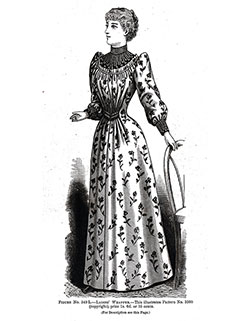
In this instance, the wrapper is shown daintily made up in figured China silk and plain velvet. The fronts are shirred to form a ruffle finish at the top, and adjusted upon fitted basque-fronts of lining, which show above in round-yoke shape.
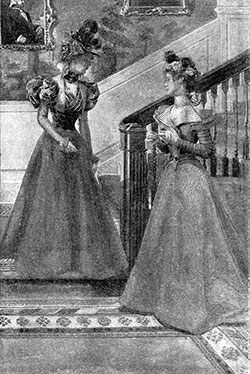
New Easter Costumes for March 1897
The materials shown for the early Easter costumes range from the smooth cloths and mixed suitings down to the pretty lightweight silks, heavier striped moirés, and miroir effects in wool. The suitings in checks show the mixed effect caused by the skillful intermingling of many threads of different colors.
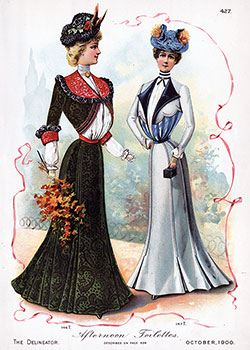
Ladies Afternoon Costumes - 146 T and 147 T - 1900
This stylish two-piece outfit will prove acceptable for formal afternoon wear when calling, driving, etc., and is here developed in figured silk crépon and panne velvet of a contrasting color combined with plain Liberty silk.
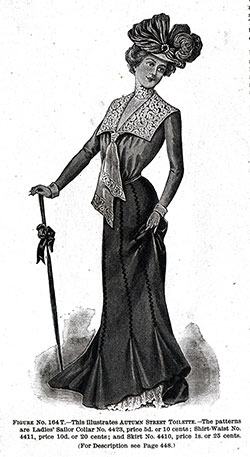
Ladies Autumn Street Costume 164 T - 1900
The severity of a plain shirt is greatly relieved by a dainty sailor-collar, and the popularity of this becoming accessory is, therefore, not surprising. The collar forming part of this attractive and straightforward outfit is here made of all-over lace over blue silk and falls square at the back.
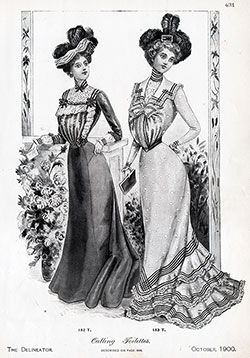
Ladies Calling Costumes 152 T and 153 T - 1900
Black velvet ribbon was associated with silk ruchings in the decoration of the stylish outfits here pictured made of figured and plain India silk and allover lace.
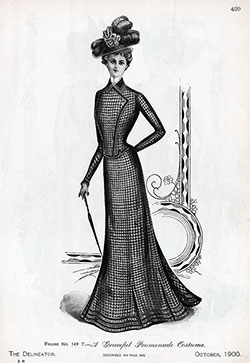
Ladies Graceful Promenade Costume 149 T - 1900
A smart jacket sans revers and a graceful five-gored skirt compose the costume stylishly developed in brown-and-white shepherd’s plaid.
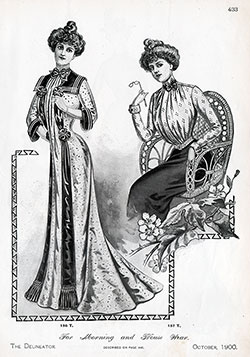
Ladies' Morning Dress and Blouse 156 T & 157 T - 1900
Figured vailing was here selected for the development of the wrapper with dark-blue satin for the sailor collar and cuff facings and a blue satin ribbon of a similar shade for the scarfs. The wrapper has a Watteau that falls out gracefully into the train and is carefully adjusted at the sides.
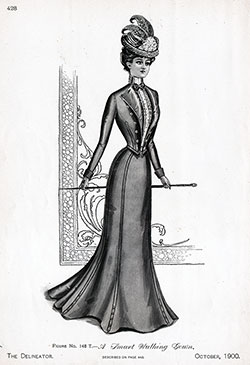
Ladies' Smart Walking Gown 148 T - 1900
The costume shows faultless adjustment and is a mode that will undoubtedly enjoy popularity. Cloth of a fashionable blue-gray tone was the material used in the present development, with silk for lining and self-strappings, buttons, and machine-stitching for decoration.
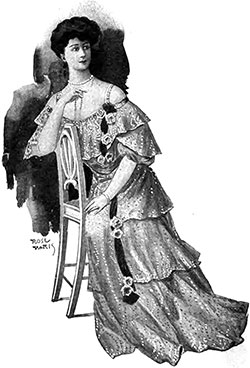
Ladies Holiday Dress Fashions 1904
There is this season, a great variety of designs that are fashionable. The picturesque has many admirers, while the severely simple style also has its followers. White, black, and some other different colors are considered smart.
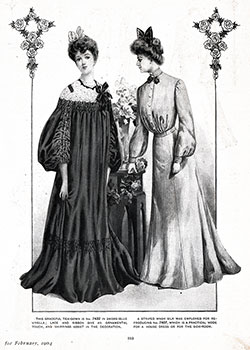
Ladies Dresses and Tea Gowns 7407 7432 - 1904
This graceful tea-gown is No. 7432 in smoke-blue Viyella; lace and ribbon give a decorative touch, and shirrings assist in the decoration. Striped wash silk was employed for reproducing No. 7407, which is a practical mode for a house dress or the sick-room.
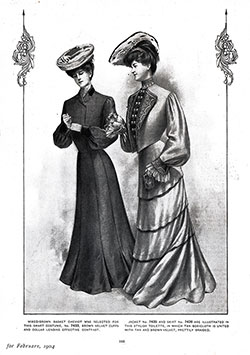
Ladies Smart Stylish Costumes No. 7433, 7435 & 7426 - 1904
Mixed-brows basket cheviot was selected for this smart costume, No. 7433, brown velvet cuffs and collar lending effective contrast. Jacket no. 7435 and skirt No. 7426 are illustrated in this stylish costume, in which tan box-cloth is united with tan and brown velvet, prettily braided.
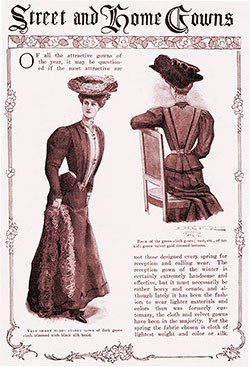
The reception gown of the winter is certainly extremely handsome and effective, but it must necessarily be rather heavy and ornate, and although lately it has been the fashion to wear lighter materials and colors than was formerly customary, the cloth and velvet gowns have been in the majority.
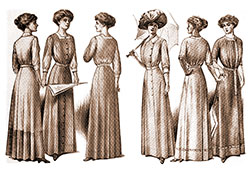
Serviceable Tub Dresses - 1910
Comfort dresses, that is the new name the up-to-date girl calls her tub dresses this year; and she plans them in every particular so that they will be a credit to their name.
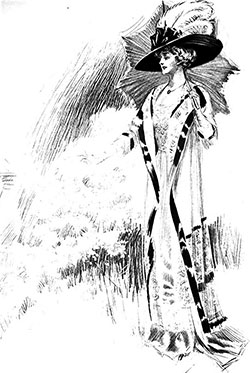
Complex Character of Chiffon Wraps and Dresses - 1910
Transparent wraps and dresses call for marvelous foundations of silk and chiffons according to an article on the complex character of the new chiffon wraps and dresses by Mrs. Simcox, New York’s greatest dressmaker and arbiter of the modes in this country.
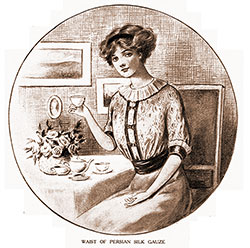
Bridge Gowns and Dresses - January 1911
Dainty mazy puzzles and blues with odd touches of red or elusive yellows or greens are blended bewilderingly and really most beautifully in the Eastern prints on silk or cotton. Of these many beautiful bridges, waists are made up this year.
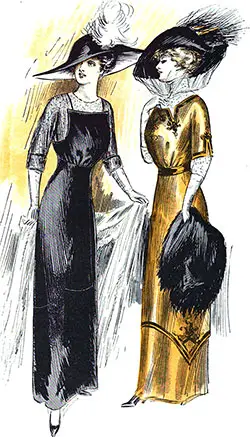
Delightful Dresses Intended for House Wear - 1911
Of all ambiguous words and phrases, “house dress” seems to be the one that carries with it the most significant element of uncertainty so far as I am able to judge. Only recently a perplexed young bride wrote to me from the Middle West and asked me what she should wear for breakfast at hotels on her honeymoon.
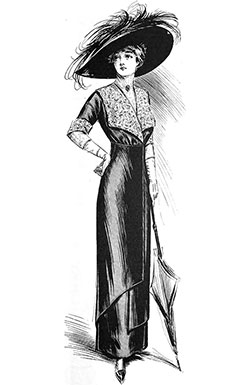
Semi-Empire Dresses and Eton Jackets For Spring - 1911
A delightful dress made for a well-known mondaine who is booked for Cannes for the middle of the month rings in a new variation on the semi-Empire styles. The waistline of the skirt is raised an inch or two in a deep yoke that reaches well below the hip.
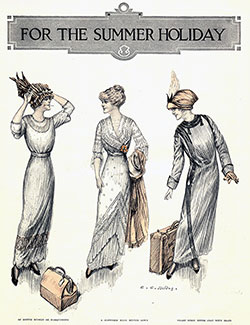
A very becoming gown can be made from the first design on this page. Supposing that muslin or marquisette has been the material is chosen—a colored background with white dots—the bottoms of the skirt and sleeves are bound with a plain green or blue to match.
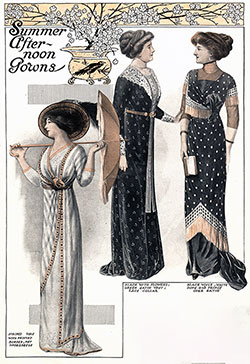
In designing gowns, there is always to be borne in mind the woman who will be comfortable in summer at any cost of pride or fashion. This woman terribly distresses her ambitious dressmaker by her perfect disregard of summer finery.
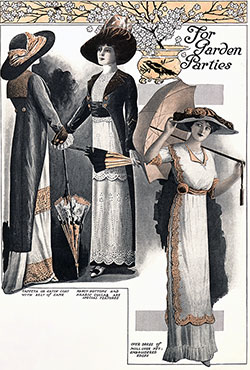
Dressed For Garden Parties - 1912
One can no longer procrastinate about the question of midsummer gowns, especially if one's summer consists of only two or three hot months. We have already wearied of the tailored suit and in all probability have enjoyed the unfailing reward of having invested, in early spring, in a satin gown or three-piece costume, such as a taffeta or a charmeuse.
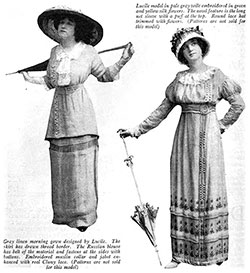
Recipe for a Summer Dress 1912
I shall never believe that a woman should be a slave to her dresses, and that is what “the fashions” make her. But I do think that dress was made for a woman to form into coverings of such lines and colors as will best set off her charms and her individuality.
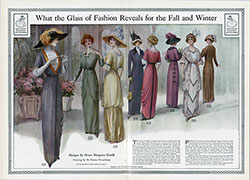
Beautiful Fashions For Fall and Winter - 1912
The silhouette is changing, but only for the better. It is losing some of its straight lines, hut for every straight line that it has given up a curve of beauty has come in its place. Soft draperies and gracefully modified panniers are new substitutes for the straight, hopelessly plain skirts.
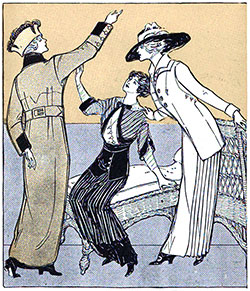
New Touches for Old Dress Ensembles - September 1912
As one by one the old garments are brought forth from their tissue-paper nests, they appear in a new light. The suit or gown that looked so hopelessly worn out when it was consigned to the cedar chest seems to be almost wearable.
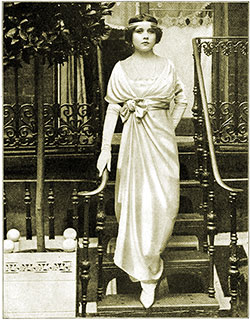
Latest Street Costumes From Paris - November 1912
The gilding of the leaves and the sharp, fresh indescribable “something” in the air which one instinctively senses as autumn, is bringing back from the shore and mountains “La Parisienne,” who is again taking her morning airing in Le Bois, looking as adorable and chic as ever in the smartest of smart little-tailored suits.
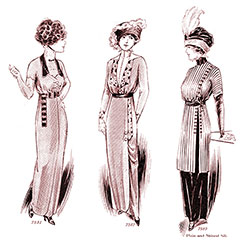
Dresses as Seen on Fifth Avenue - Spring 1913
It looks like really, truly spring on the Avenue these days, with the throngs of well-dressed women wearing the smartest of spring clothes and such chic little hats; and every woman you meet has such a dear little posy in the lapel of her coat if she wears a tailored suit, or at her girdle if she wears a one-piece frock or a dressy afternoon gown.
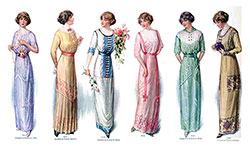
Bordered Materials and Flouncings on Dresses - 1913
Bordered voiles, both of silk or cotton, and bordered taffetas and foulards will make up attractively in this design. If made of an embroidered flouncing, the yoke should be of tucked lawn or batiste, but if silk or wool is used, then chiffon would be in better taste.
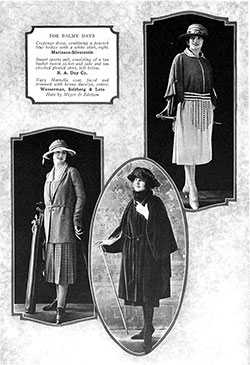
Spring Dresses and Gowns - January 1922
Crepe faille, kitten's ear crepe, crepe Elizabeth, crepe Renee and Crepe Roma are very generally adopted, in many instances approved for the morning, afternoon, and evening dress alike, with fine impartiality.
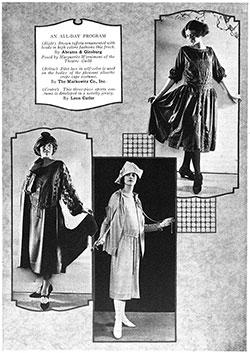
Spring Season's Dresses and Gowns - February 1922
The long favored straight-line frock also gives way in this group before the lew blouse silhouette. This is achieved by wide panels bloused over a girdle or the full blouse bodice section of straight or surplice lines.
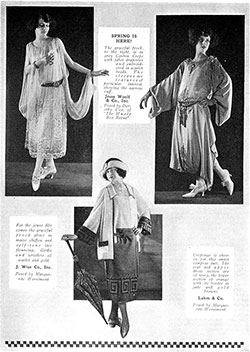
Dresses and Gowns Find Themselves - 1922
Leading tendencies resolve themselves into three final silhouettes—the long blouse above a straight line lower section, the long blouse above a draped lower section and the long waist effect introduced as the newer feature of the straight-line, one-piece dress.
